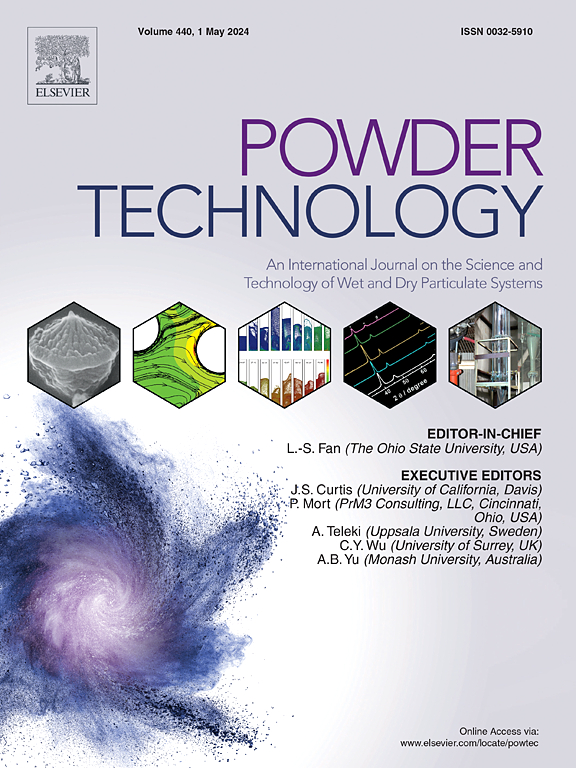Flow properties of uranium dioxide control-shaped powders: Link with the particle morphology and size of asperities
IF 4.5
2区 工程技术
Q2 ENGINEERING, CHEMICAL
引用次数: 0
Abstract
In a nuclear fuel fabrication process, knowledge of flow properties is essential. Indeed, fuel manufacturing is based on a powder metallurgy process and each of its stages requires a good flowability. In this work, we propose to establish a quantitative link between the morphology and asperities of uranium dioxide powder particles and their flow properties. To this end, model uranium dioxide powders with a controlled particle size distribution and a controlled shape have been fabricated. A method was used, based on the image analysis resulting from the 2D projection of each particle, to characterize the morphology of the powder particles. These images were obtained using a scanning electron microscope on resin-coated particles. The morphological parameters chosen to characterize the powder are elongation, circularity and solidity. Rheological properties are obtained using an FT4 powder rheometer: the powder undergoes different tests (permeability, compressibility, and shear) to quantify its flowability. We were able to confirm that the finer the particles making up the powder, the worse the powder flow, and that the more spherical the particles making up the powder, the better the powder flow. Finally, we characterize the asperities of uranium dioxide powder particles and discuss the link between flow and Bond number using our data and data from the literature.

二氧化铀控制型粉末的流动特性:与颗粒形态和颗粒大小有关
在核燃料制造过程中,流动特性的知识是必不可少的。事实上,燃料制造是以粉末冶金工艺为基础的,它的每个阶段都需要良好的流动性。在这项工作中,我们建议建立二氧化铀粉末颗粒的形态和凹凸度与其流动特性之间的定量联系。为此,制备了具有可控粒度分布和可控形状的二氧化铀模型粉末。采用了一种基于二维投影图像分析的方法来表征粉末颗粒的形态。这些图像是用扫描电子显微镜在树脂包覆颗粒上获得的。表征粉末的形态参数是伸长率、圆度和固体度。使用FT4粉末流变仪获得流变特性:粉末经过不同的测试(渗透性、压缩性和剪切性)来量化其流动性。我们能够确认粉末的颗粒越细,粉末的流动性就越差,而粉末的颗粒越球形,粉末的流动性就越好。最后,我们描述了二氧化铀粉末颗粒的粗糙度,并利用我们的数据和文献中的数据讨论了流动和Bond数之间的联系。
本文章由计算机程序翻译,如有差异,请以英文原文为准。
求助全文
约1分钟内获得全文
求助全文
来源期刊

Powder Technology
工程技术-工程:化工
CiteScore
9.90
自引率
15.40%
发文量
1047
审稿时长
46 days
期刊介绍:
Powder Technology is an International Journal on the Science and Technology of Wet and Dry Particulate Systems. Powder Technology publishes papers on all aspects of the formation of particles and their characterisation and on the study of systems containing particulate solids. No limitation is imposed on the size of the particles, which may range from nanometre scale, as in pigments or aerosols, to that of mined or quarried materials. The following list of topics is not intended to be comprehensive, but rather to indicate typical subjects which fall within the scope of the journal's interests:
Formation and synthesis of particles by precipitation and other methods.
Modification of particles by agglomeration, coating, comminution and attrition.
Characterisation of the size, shape, surface area, pore structure and strength of particles and agglomerates (including the origins and effects of inter particle forces).
Packing, failure, flow and permeability of assemblies of particles.
Particle-particle interactions and suspension rheology.
Handling and processing operations such as slurry flow, fluidization, pneumatic conveying.
Interactions between particles and their environment, including delivery of particulate products to the body.
Applications of particle technology in production of pharmaceuticals, chemicals, foods, pigments, structural, and functional materials and in environmental and energy related matters.
For materials-oriented contributions we are looking for articles revealing the effect of particle/powder characteristics (size, morphology and composition, in that order) on material performance or functionality and, ideally, comparison to any industrial standard.
 求助内容:
求助内容: 应助结果提醒方式:
应助结果提醒方式:


